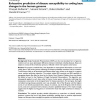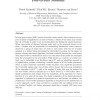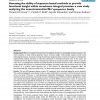1495 search results - page 295 / 299 » Confirmation in Multimodal Systems |
BMCBI
2008
13 years 11 months ago
2008
Background: Single Nucleotide Polymorphisms (SNPs) are the most abundant form of genomic variation and can cause phenotypic differences between individuals, including diseases. Ba...
CN
2008
13 years 11 months ago
2008
In large peer-to-peer (P2P) overlay networks, nodes usually share resources to support all kinds of applications. In such networks, a subset of the nodes may assume the role of br...
BIOINFORMATICS
2006
13 years 11 months ago
2006
Motivation: Most previous approaches to model biochemical networks havefocusedeither on the characterization of a networkstructurewith a number of components or on the estimation ...
BMCBI
2007
13 years 11 months ago
2007
Background: The Stanford Tissue Microarray Database (TMAD) is a repository of data serving a consortium of pathologists and biomedical researchers. The tissue samples in TMAD are ...
BMCBI
2007
13 years 11 months ago
2007
Background: Efforts to predict functional sites from globular proteins is increasingly common; however, the most successful of these methods generally require structural insight. ...



